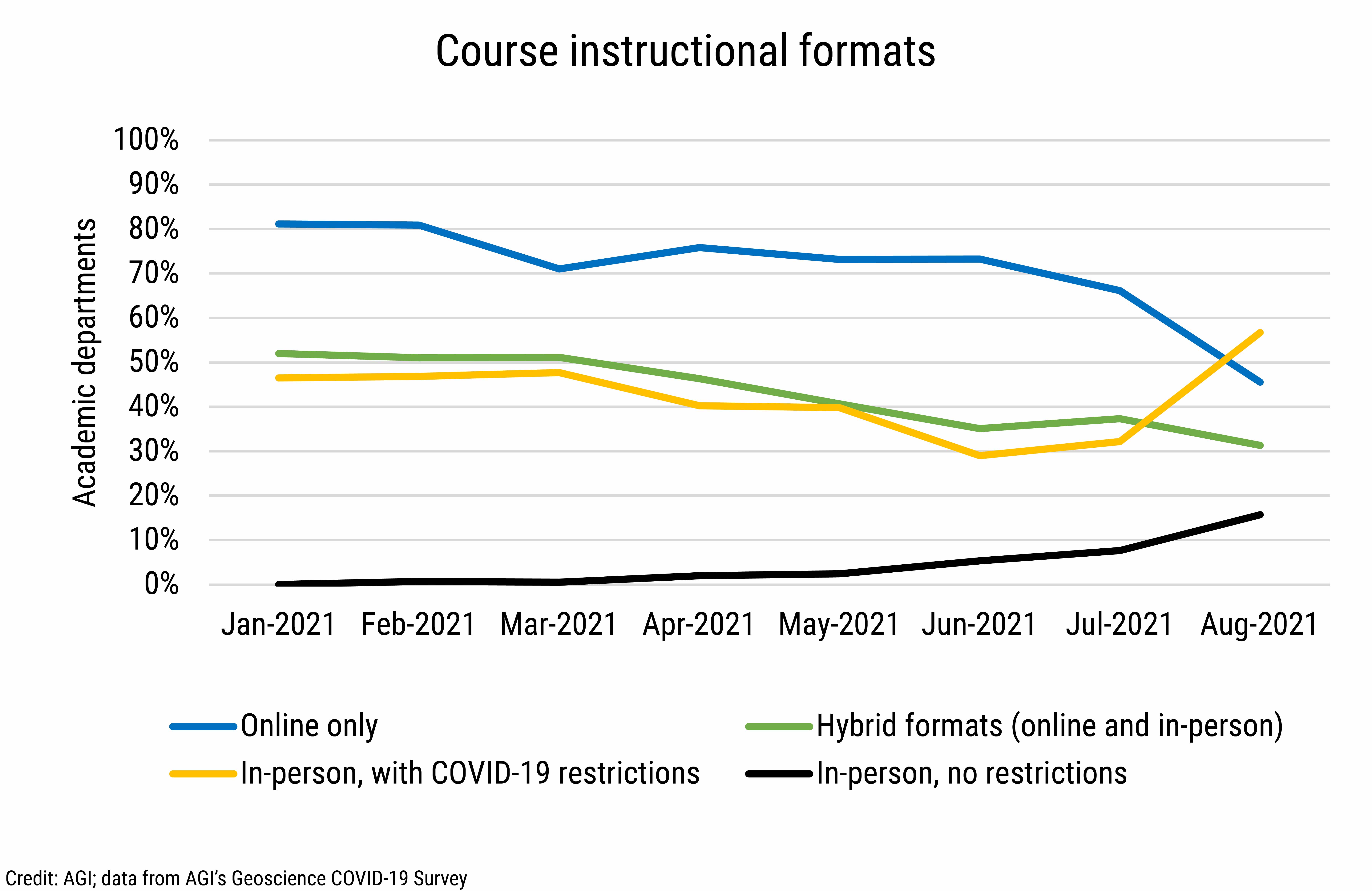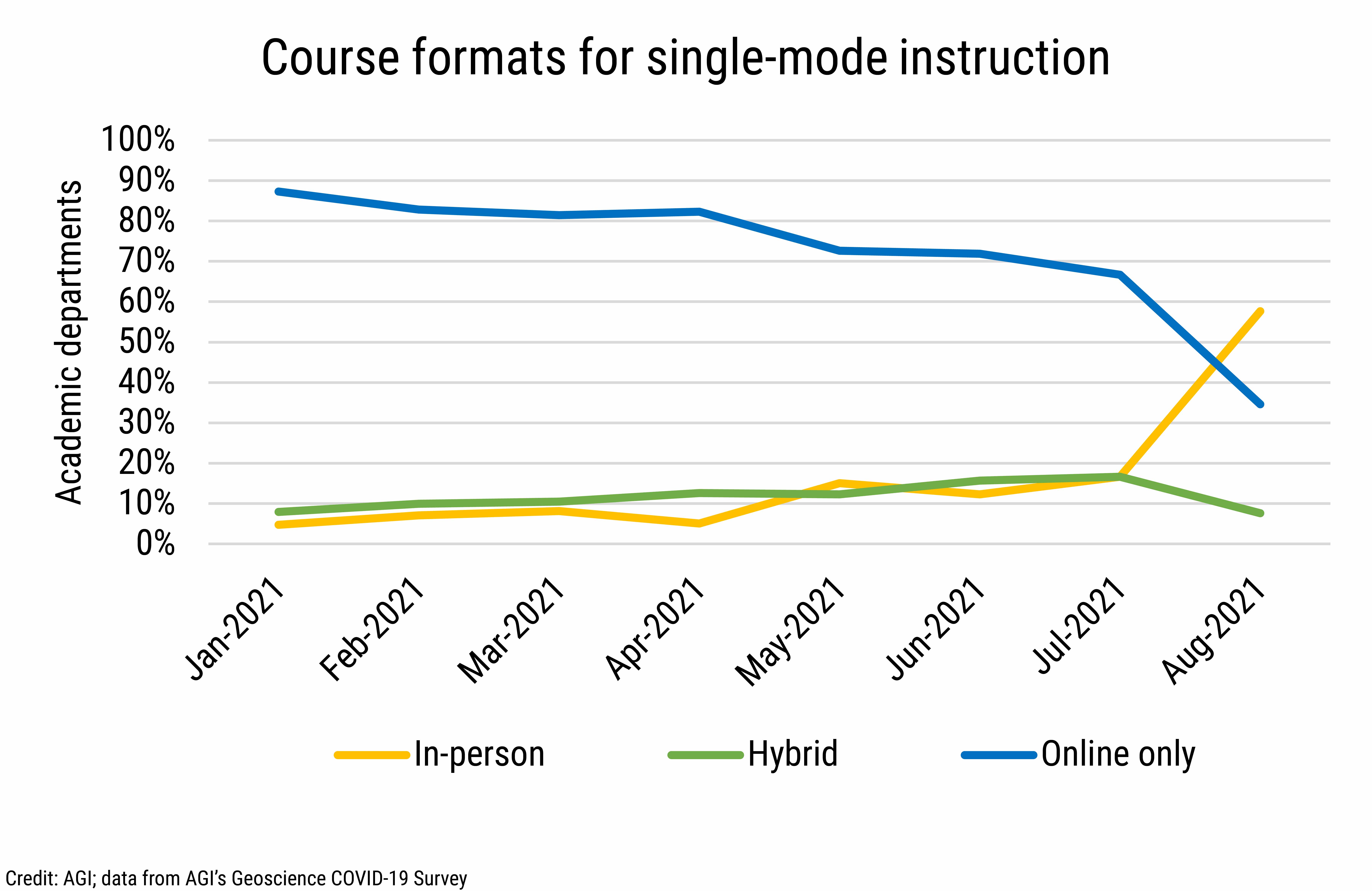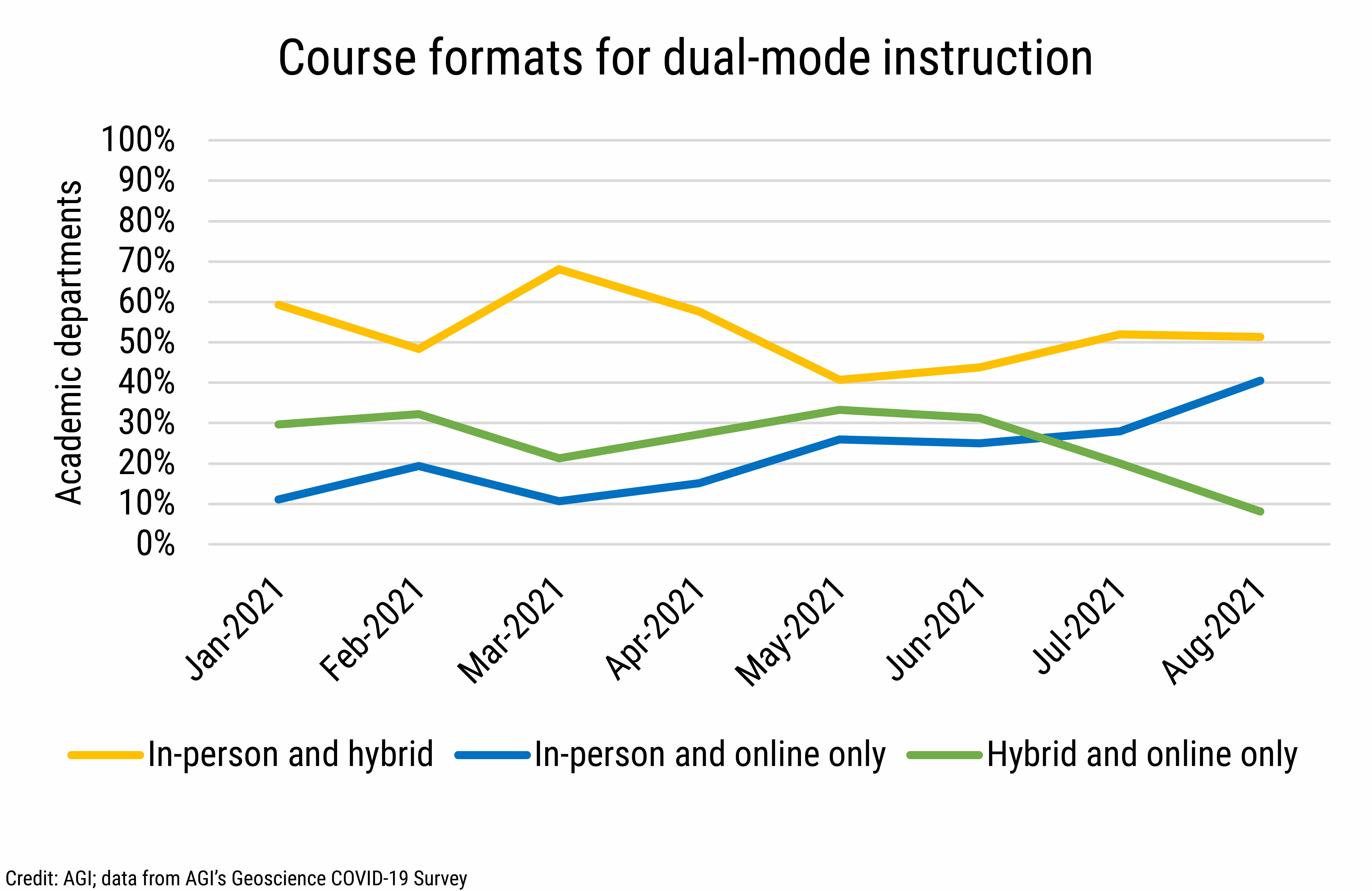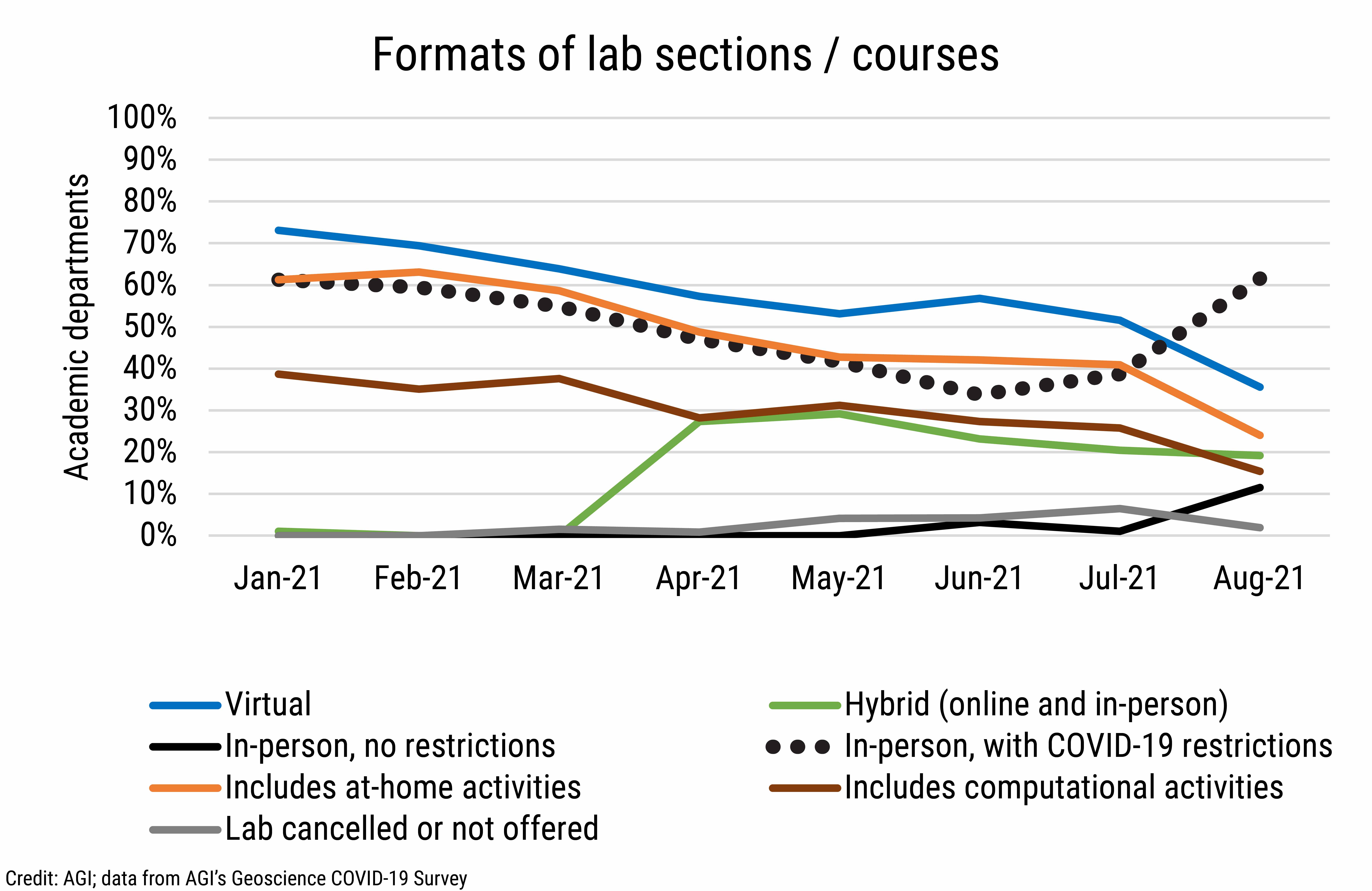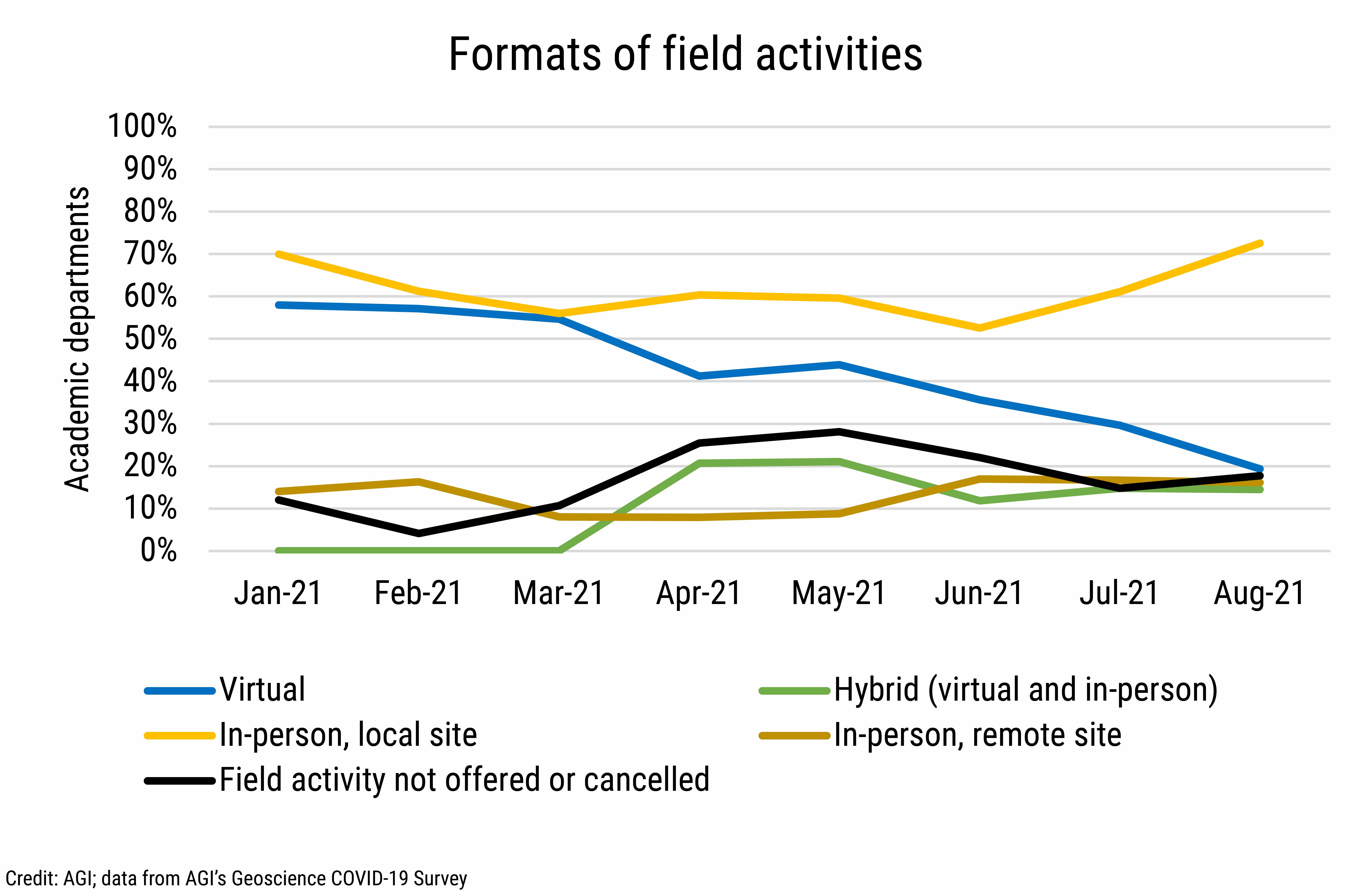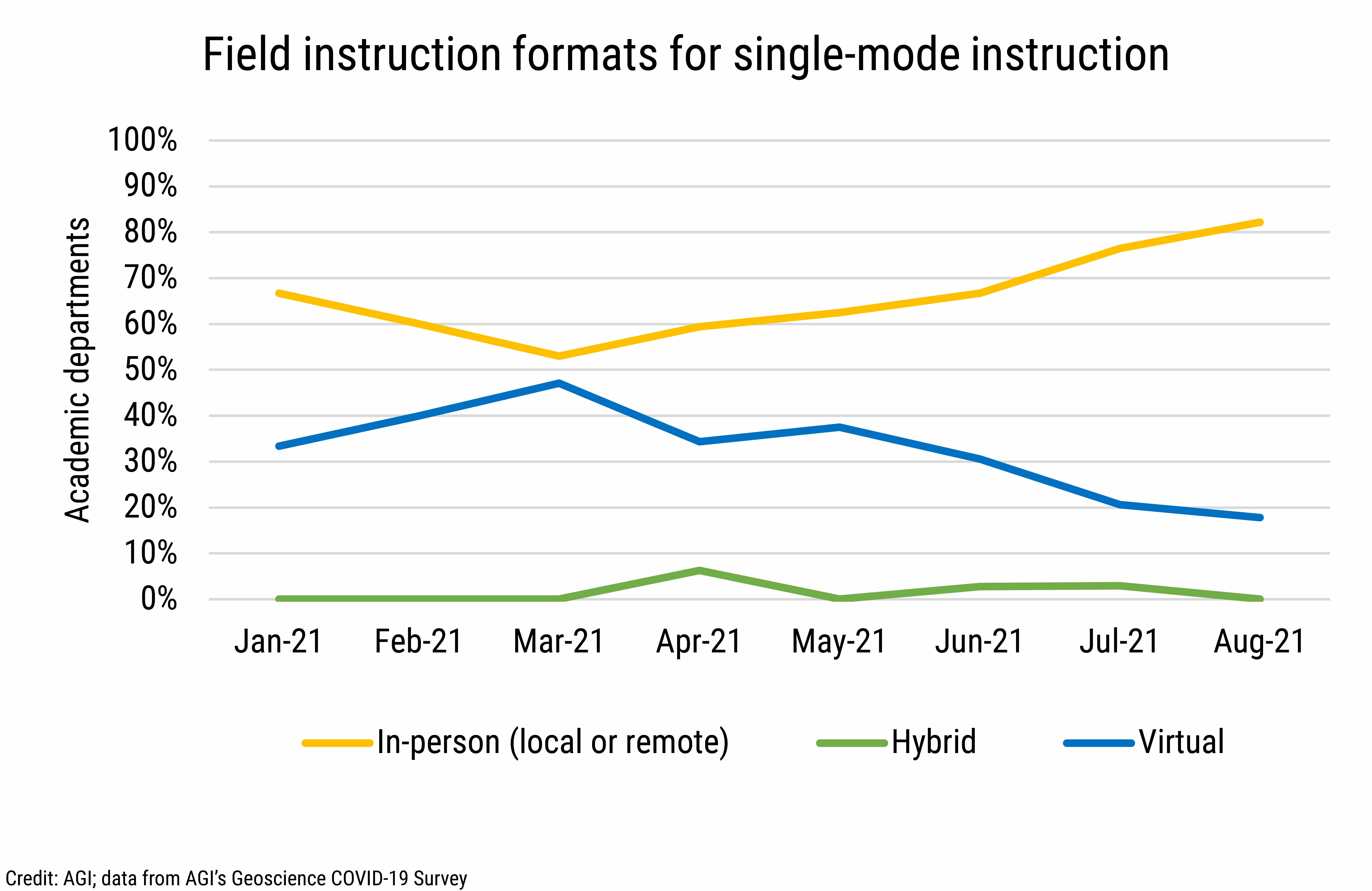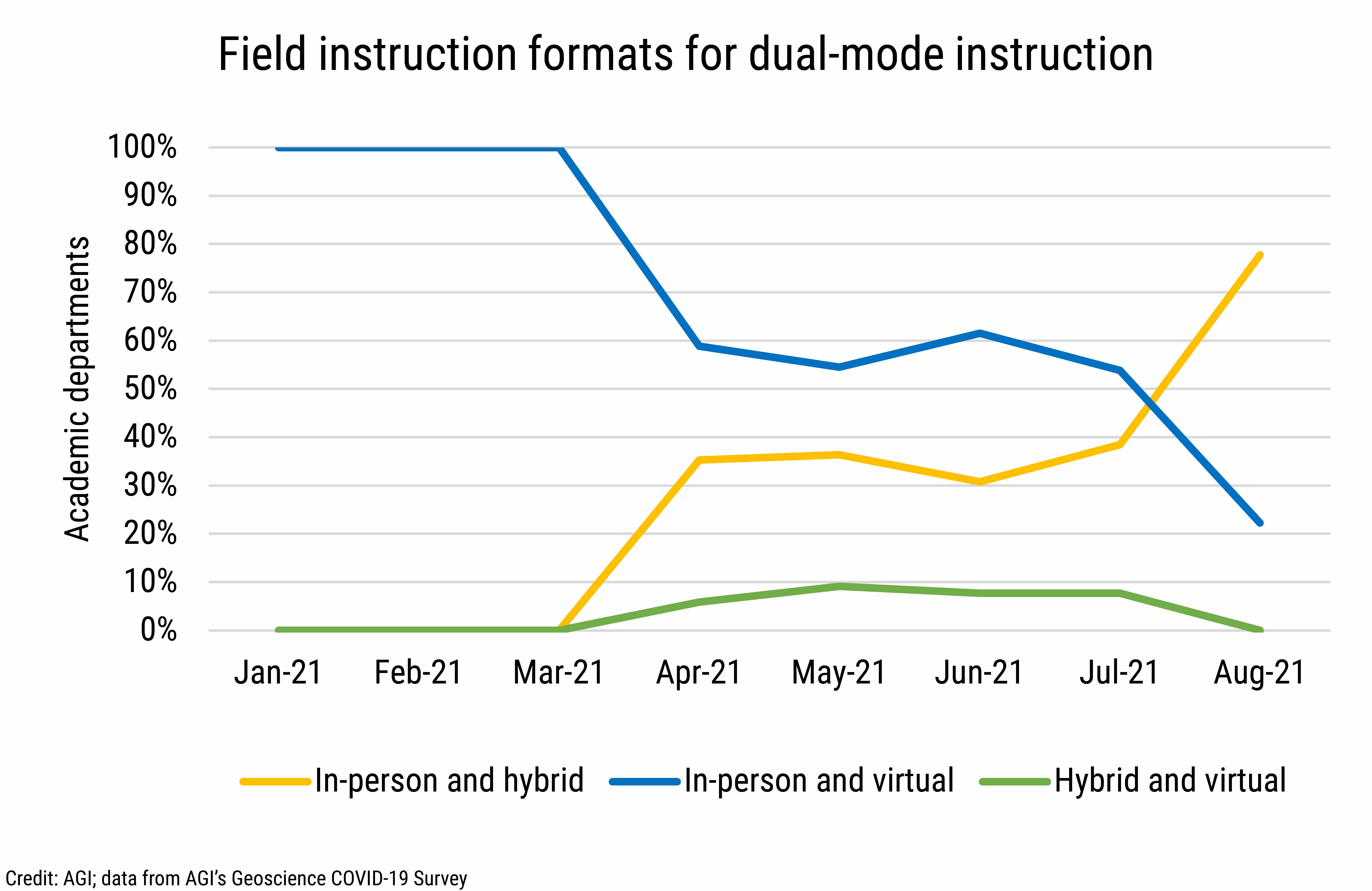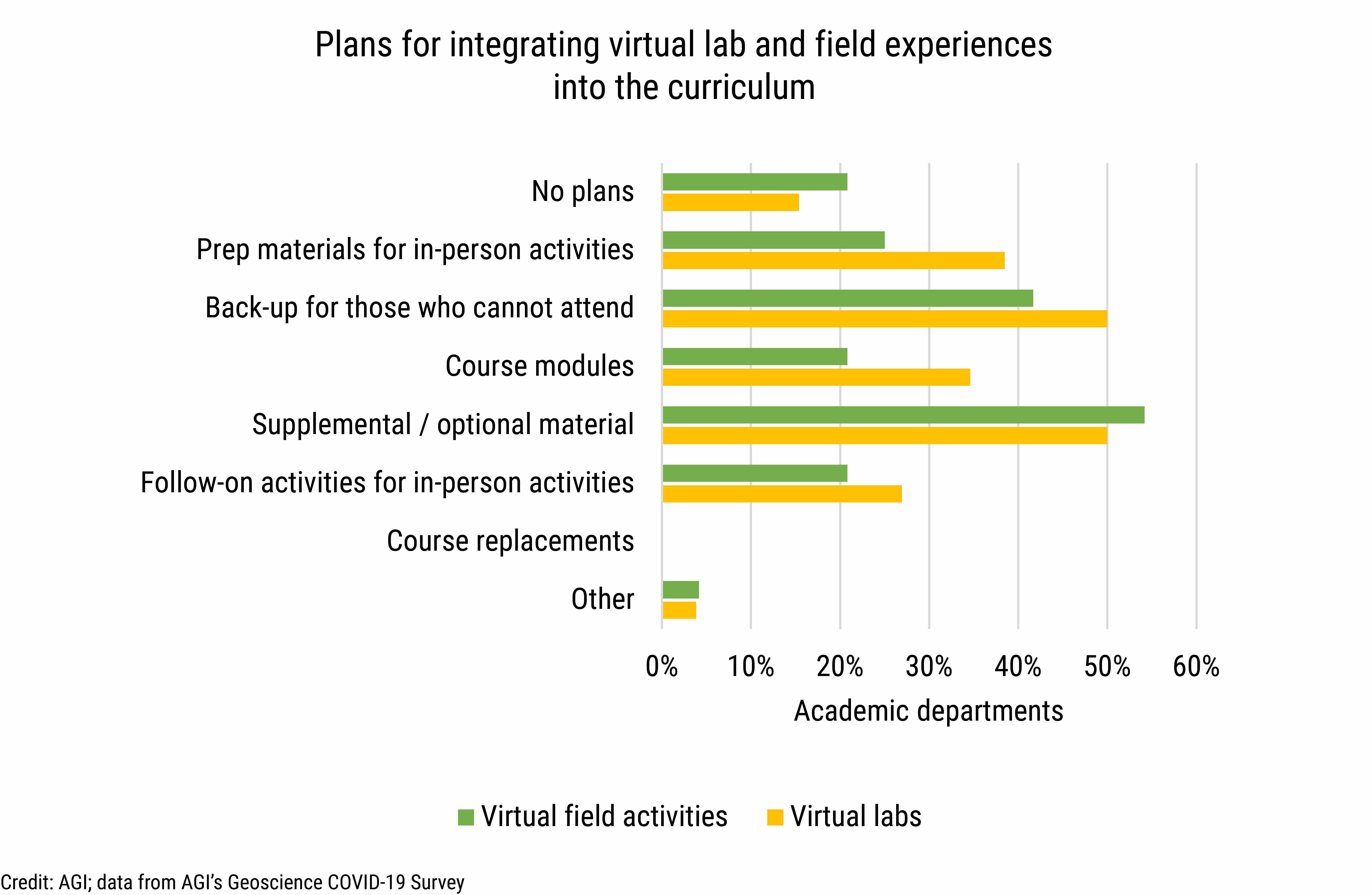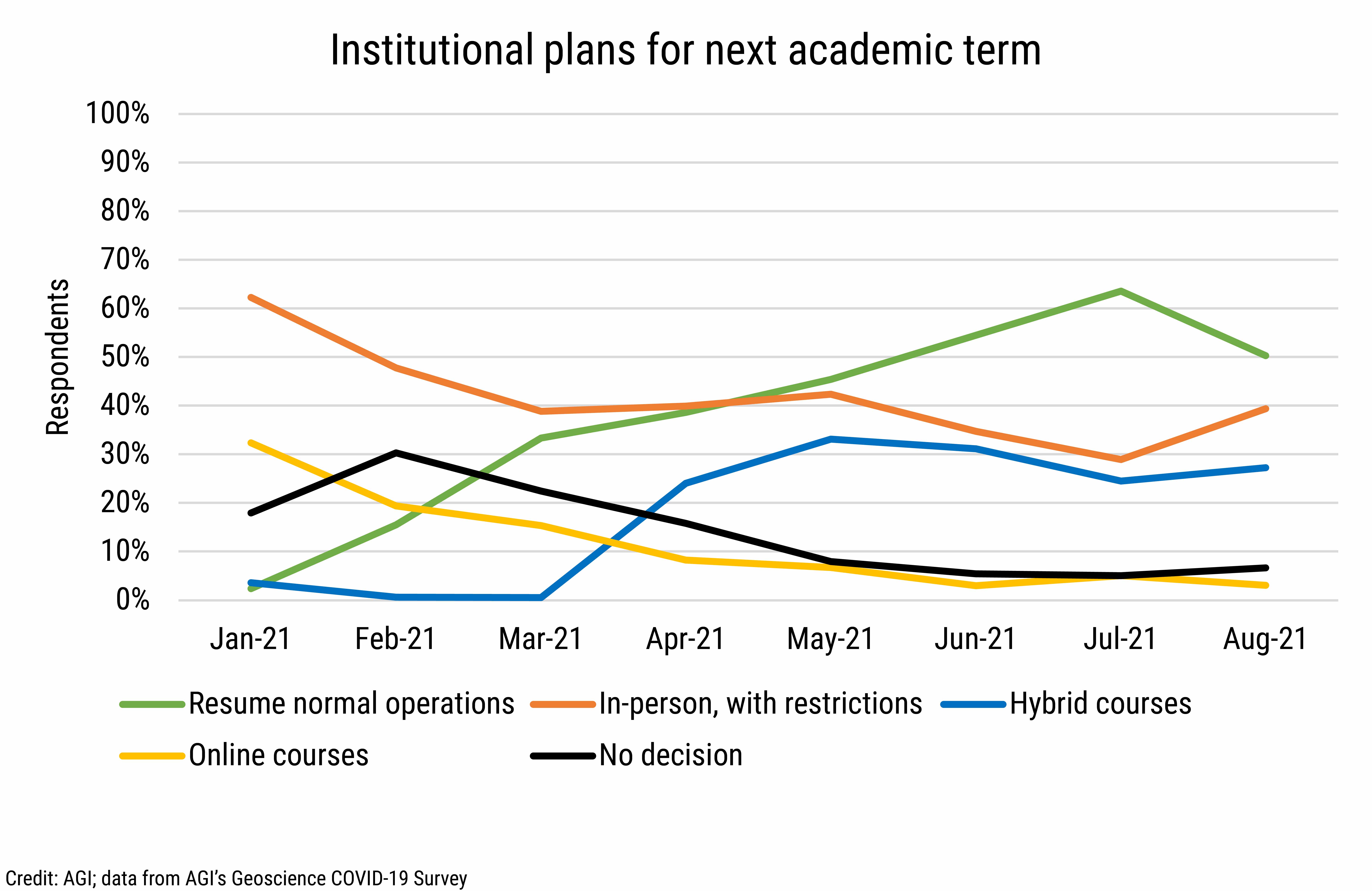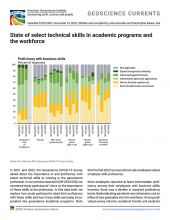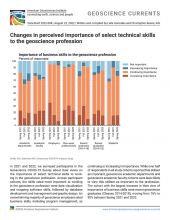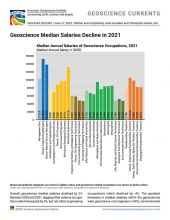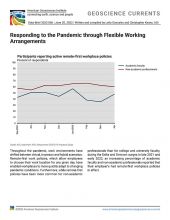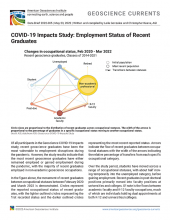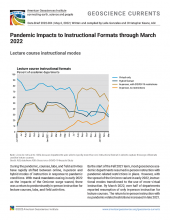The pandemic has led to rapidly changing requirements for educational instruction. We examine the changes over this year in instructional formats for courses, labs, and field activities, the plans for integrating virtual components into the curriculum, the new instructional opportunities that are being explored by departments and faculty, and the expectations for instructional formats in the next academic term.
Instructional formats
By August 2021, 38% of departments reported multiple delivery formats for geoscience courses which was down from half of departments reporting the same at the start of 2021. In-person instruction was the primary form of delivering courses, with 57% of departments reporting in-person instruction with COVID-19 restrictions and 16% of departments reporting in-person instruction with no restrictions. The most common pandemic-related restrictions reported by departments were the use of face masks. In August 2021, online-only instruction was reported by 46% of departments (down from 81% in January 2021) and hybrid formats by 31% of departments (down from 52% in January 2021).
Courses with a single-mode of instruction have increasingly switched from online instruction to in-person instruction. In August 2021, for the 30% of courses with dual modes of delivery, the focus was a mix of in-person and hybrid instruction.
In August 2021, over 70% of departments reported conducting in-person labs, and while most departments implemented COVID-19 restrictions for in-person labs, just over 10% of departments reported no pandemic-related restrictions. The percentage of departments using multiple instructional formats for labs declined from 41% in January 2021 to 25% in August 2021, with in-person instruction being the most common delivery format for single-mode instruction followed by virtual instruction. In addition, there has been a steady decline in the inclusion of at-home and computational lab activities that has been concurrent with the decline in virtual instruction.
Field instruction remains dominantly in-person, with over 70% of departments reporting this instructional modality in August 2021. The percentage of departments using virtual field instruction declined from 58% in January 2021 to 19% in August 2021.
The percentage of departments offering multiple modes for field instruction declined from 42% in January 2021 to 18% in August 2021. In-person instruction remains the primary mode of instruction for single-mode field instruction, and a combination of in-person and hybrid instruction was the most frequently reported dual-mode field instructional format in August 2021.
Integrating virtual instruction
When asked about plans for long-term integration of virtual lab and field experiences into the curriculum, most departments indicated in June 2021 that they planned to integrate virtual lab and field experiences into their curriculum, but not as replacements for in-person labs or field courses. Virtual labs and field activities were viewed as supplemental material for existing courses or as back-up material for students who could not attend in-person. About one-third of departments indicated that they planned to use virtual labs as course modules or as preparatory material for in-person activities. In addition, 21% of departments indicated plans to use virtual field activities as course modules and 25% of departments indicated plans to use virtual field activities as preparatory material for in-person activities.
Changes in courses and degree programs
In May 2021, 27% of faculty indicated that their department was phasing in new courses or degree tracks during the 2021-2022 academic year, including new degree programs at the undergraduate and graduate level, new courses that will be developed and taught by new faculty joining the department, new field courses, new minors and concentration tracks in existing degree programs, and development of microcredentials. Program and course topics included sustainability, coastal processes, GIS, volcanology, computational geoscience, climate change, polar oceanography, oceanographic modeling, water resources, soil science, geo-intelligence, data analytics, and mineral exploration leadership.
When asked if their department planned to phase out existing courses or degree tracks during the 2021-2022 academic year, only 7% of faculty indicated that this would happen. Reasons for phasing out existing courses included reducing redundancy with content covered in other courses, eliminating courses that had lost relevance to the discipline, discontinuing courses that had been taught by faculty that had since left the institution, and shifting required courses to elective options.
New Opportunities
One third of departments and faculty indicated that the pandemic provided them the opportunity for to explore new areas of work and/or research. New opportunities mentioned by departments included the development of virtual instructional materials that can be used and adapted for different modalities, research into effective online pedagogy, improvement of department culture and development of inclusive pedagogy, and specific projects related to health, supply chain management, and climate mitigation.
New opportunities mentioned by faculty focused on increased online collaboration which resulted in new projects and research publications, the continued development and use of virtual instructional materials that were being integrated into existing courses, the exploration of ways to teach more online courses, the use of 3D resources in courses, and the improvement of computational research and skills which resulted in more robust research projects.
Next term plans
Since January 2021, institutional planning for the next academic term has increasingly focused on a return to normal operations, with these expectations peaking in July when 64% of departments reported that they expected to resume normal operations for the next term. In August, 50% of departments reported expectations to return to normal operations in the next academic term, while 39% indicated expectations of in-person operations with pandemic-related restrictions in place. Expectations for the use of hybrid course formats was reported by 27% of departments in August 2021.
We will continue to provide current snapshots on the impacts of COVID-19 on the geoscience enterprise throughout the year. For more information, and to participate in the study, please visit: https://www.americangeosciences.org/workforce/covid19
Funding for this project is provided by the National Science Foundation (Award #2029570). The results and interpretation of the survey are the views of the American Geosciences Institute and not those of the National Science Foundation.



